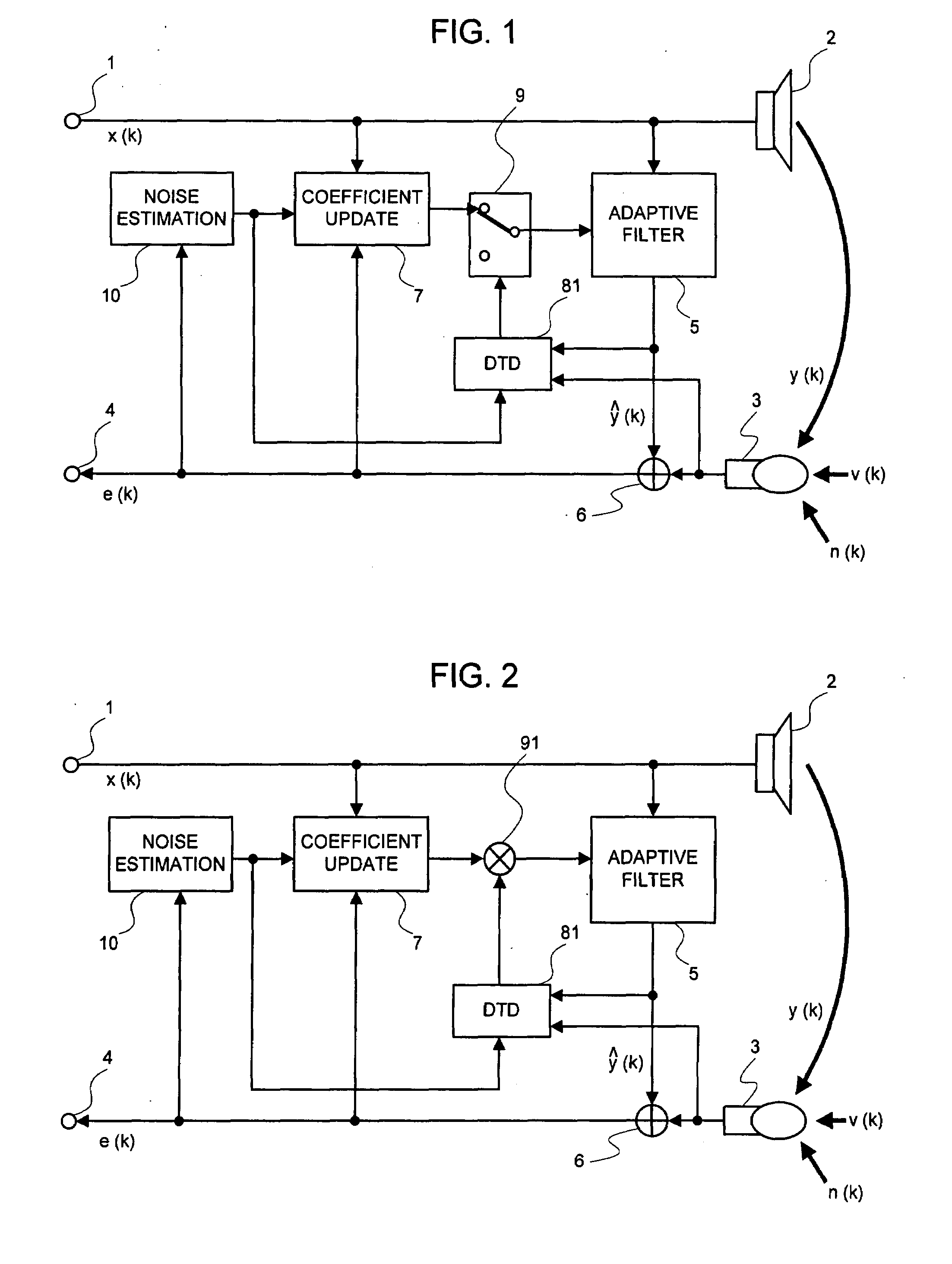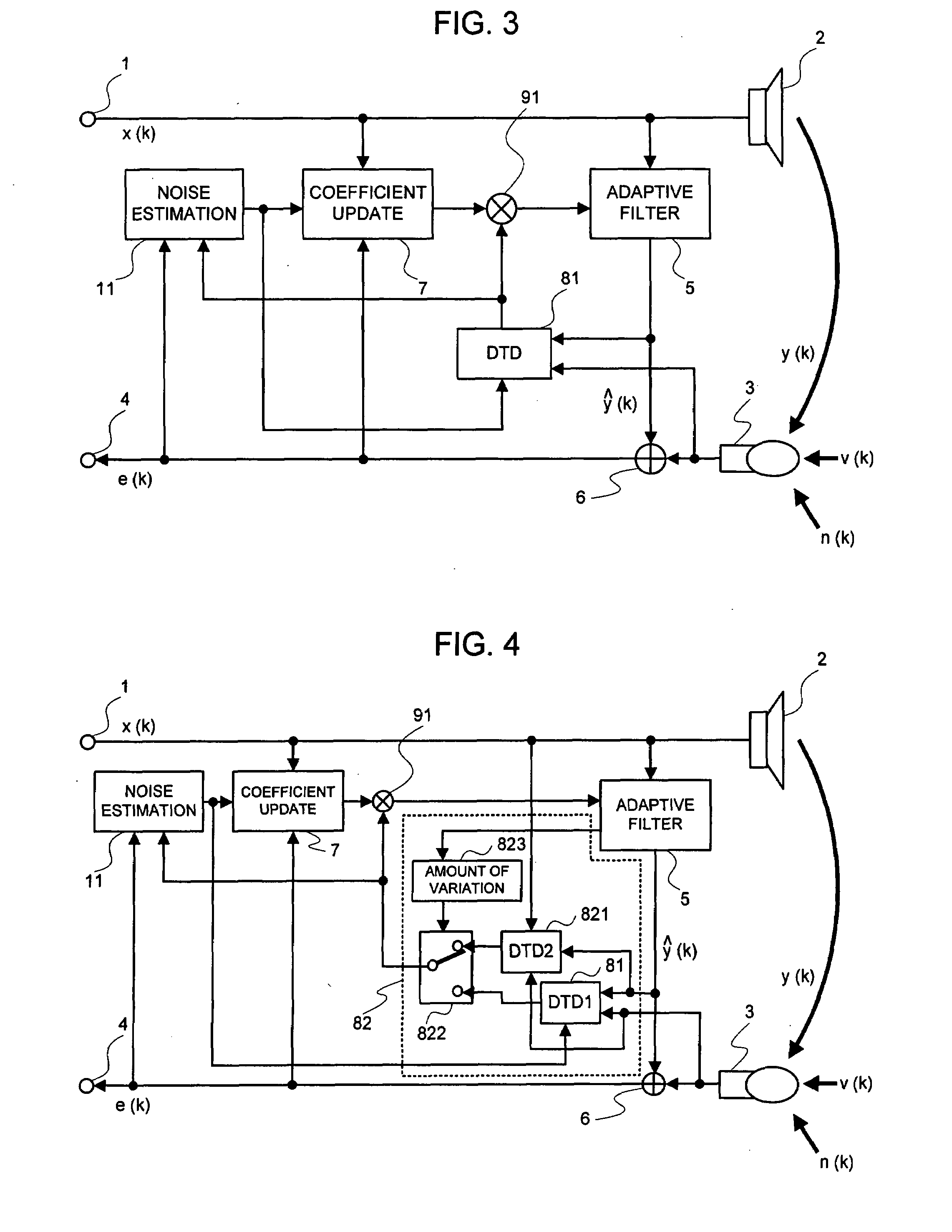Signal Processing Method, Signal Processing Device, and Signal Processing Program
a signal processing and signal processing technology, applied in the direction of frequency response correction, instruments, electrical transducers, etc., can solve the problems of increasing computational complexity, increasing computational complexity, and increasing the required memory size, so as to reduce computational complexity, accurate control of coefficient update, and high performance of removing echoes
- Summary
- Abstract
- Description
- Claims
- Application Information
AI Technical Summary
Benefits of technology
Problems solved by technology
Method used
Image
Examples
embodiment 1
[0097]The double-talk detecting circuit 81 is supplied with a microphone signal m(k) and a pseudo echo y(k) hat. A procedure to detect a double talk using these signals will be given below:
[0098]Applying rxm=Rxxh to EQ. (9) gives EQ. (12):
[Equation5]ξ=hTRxxhσm2.(12)
[0099]Using an approximation of EQ. (10), i.e., h W(k), and paying attention to the fact that E[hTX(k)]=E[y(k) hat], the following equation is obtained:
[Equation6]ξ(k)=E[y^(k)2]σm2.(13)
In this equation, ξ is time-varying and therefore it is given as a function of k. The calculation of EQ. (13) consists of one multiplicative operation for a numerator in the radical sign, and one multiplicative operation for a denominator therein. In practice, σm2 is the average power of the microphone signal m(k), and is determined as:
[Equation7]σm2(k)=∑j=0M-1m2(k-j).(14)
Since EQ. (14) is a moving average of m2(k), it can be calculated for a past value by an additive operation of m2(k) and a subtractive operation of m2(k-M) in practice. Th...
embodiment 2
[0116]In an embodiment 2, a time-varying threshold is applied to ξ(k). From EQ. (26), the value of ξ(k) in a double talk is approximately dependent upon a ratio between the power of a near-end signal and the power of an echo. Thus, if the power of a near-end signal and the power of an echo can be estimated, the value of ξ(k) in a double talk can be determined. The power of an echo can be sequentially determined by approximating it with the power of a pseudo echo. The power of a near-end signal can be calculated similarly to EQ. (21) as:
v2(k)hat=Ave[e2(k)]. (27)
The calculation of Ave[·] can be achieved using the moving average as given by EQ. (14) or (15), or a linear leaky integration represented by:
v2(k+1)hat=v2(k)hat+(1−δv)·e2(k), (28)
where δv is a time constant for averaging. For δv, adaptive control similar to that for δn may be used.
[0117]As can be clearly seen from EQ. (23), EQ. (28) is calculated to update v2(k) hat only when the residual echo and noise are substantially sm...
embodiment 3
[0119]An embodiment 3 shown in FIG. 2 comprises a multiplier 91 in place of the switch 9. The double-talk detecting circuit 81 supplies to the multiplier 91a reliability coefficient for a double talk expressed by a continuous value between zero and one. The multiplier 91 multiplies the amount of coefficient update supplied from the coefficient updating circuit 7 by the reliability coefficient, and then transmits a result to the adaptive filter 5. Thus, coefficient update is made by the amount corresponding to the reliability coefficient for a double talk. This means that coefficient update is completely suspended if a double talk is confidently decided, and is made by an amount corresponding to the reliability if a double talk is uncertain. Thus, performance of removing echoes is improved as compared with either-or control in which coefficient update is to be made or not.
[0120]Representing a reliability coefficient as θ(k), it can be determined by:
θ(k)={ξ(k)−ξDT(k)} / {1−ξDT(k)}. (29...
PUM
 Login to View More
Login to View More Abstract
Description
Claims
Application Information
 Login to View More
Login to View More - R&D
- Intellectual Property
- Life Sciences
- Materials
- Tech Scout
- Unparalleled Data Quality
- Higher Quality Content
- 60% Fewer Hallucinations
Browse by: Latest US Patents, China's latest patents, Technical Efficacy Thesaurus, Application Domain, Technology Topic, Popular Technical Reports.
© 2025 PatSnap. All rights reserved.Legal|Privacy policy|Modern Slavery Act Transparency Statement|Sitemap|About US| Contact US: help@patsnap.com



